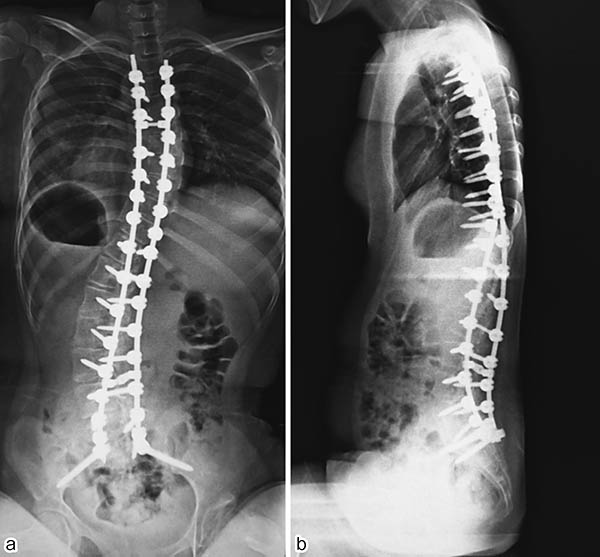1 0 0 0 OA Scoliosis surgery for handicapped children
- 著者
- Naoyuki Nakamura Yutaka Inaba Shinya Kato Takako Momose Shunsuke Yamada Yoko Matsuda Jiro Machida Yoichi Aota Tomoyuki Saito
- 出版者
- The Japanese Society for Spine Surgery and Related Research
- 雑誌
- Spine Surgery and Related Research (ISSN:2432261X)
- 巻号頁・発行日
- vol.1, no.4, pp.185-190, 2017-10-20 (Released:2017-11-27)
- 参考文献数
- 15
- 被引用文献数
- 1 1
Introduction: This study aimed to assess treatment outcomes and caregivers' satisfaction regarding scoliosis surgery for handicapped children.Methods: Handicapped children are, by definition, noncommunicatory and/or nonambulatory. We recruited 26 handicapped children who were followed-up for >1 year after a scoliosis surgery. We recruited 40 patients with adolescent idiopathic scoliosis (AIS) who underwent a surgery during the same period as controls. We used a posterior approach in all the children. We determined preoperative body mass index (BMI), main Cobb angle, Cincinnati correction index (CCI), and fusion level; intraoperative time and blood loss per level; and postoperative complications. We also assessed caregivers' satisfaction with surgical treatments for these patients using the modified Bridwell's questionnaire.Results: We have described the results as handicapped children/AIS. Median preoperative BMI was 16.1/18.6 kg/m2. Preoperative and final Cobb angles were 94.2°/59.7° and 39.7°/17.0°, respectively and CCI was 2.0/1.7. The number of fusion levels was 14.6/9.0. The operative time and blood loss per level were 40.1/44.1 minutes and 264/138 ml, respectively. Postoperative complications in handicapped children were adynamic ileus in 8 cases, dysphagia in 5, pneumonia in 3, urinary tract infection in 2, and superior mesenteric artery syndrome (SMA), surgical site deep infection, infectious enteritis, agitation, and liver dysfunction in 1 each. However, in the AIS group, there was only 1 case of SMA. Median caregivers' satisfaction score on the 0-10 visual analog scale was 9. Caregivers for 19 of the 26 handicapped cases (73%) recommended surgical treatment to caregivers of other children with the same disease.Conclusions: Surgical treatment for neuromuscular and syndromic scoliosis was associated with a high rate of postoperative complications. However, the caregivers' satisfaction score after surgery was high.
